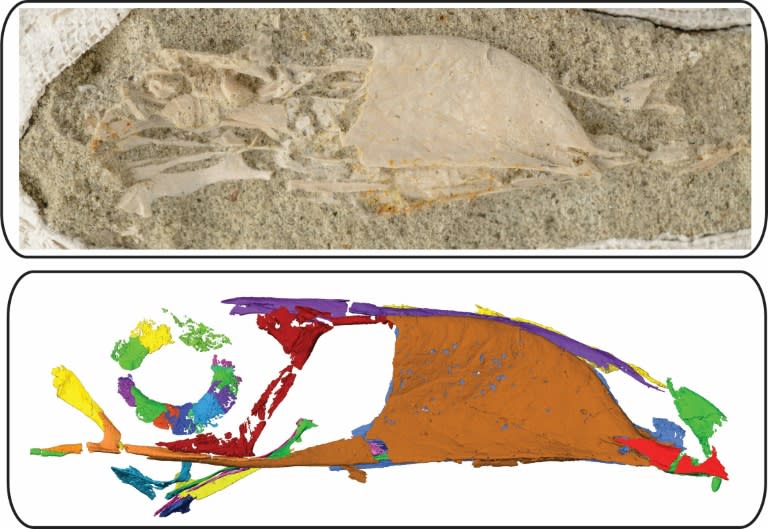[ad_1]
The discovery of a creature described as resembling a “dandelion toucan” that lived about 68 million years ago has overturned the hypothesis about the diversity of birds that lived alongside dinosaurs.
Less than nine centimeters long, the delicate skull of the bird that scientists have dubbed Falcatakely forsterae could easily be overlooked.
In fact, it almost was, sitting in a pile of fossils excavated for years before the CT scan suggested the specimen deserved more attention.
It turns out that its tall, sickle-like beak, while resembling the toucan, is something never before seen in the fossil record.
Birds in the Mesozoic era – between 250 million and 65 million years ago – had “relatively unspecialized snouts,” Patrick O’Connor, lead author of a study on the new creature, told AFP.
“Falcatakely just changed the game completely, documenting a long, tall beak unlike anything known in the Mesozoic,” added O’Connor, professor of anatomy and neuroscience at Ohio University.
The skull, described in a study published Wednesday in the journal Nature, offered more surprises.
Although Falcatakely would have had a face familiar enough to us from modern birds like toucans and hornbills, the bones that made up his face bear little resemblance to those modern creatures.
“Despite an overall face shape similar to that of modern birds such as toucans, the underlying skeleton is much more similar to non-avian theropod dinosaurs like Deinonychus and Velociraptor,” O’Connor said.
This “reverses what we know about the anatomy of Mesozoic birds.”
– ‘An almost comic profile’ –
Revealing these characteristics was not an easy task.
The fossil was originally collected in 2010 in northwestern Madagascar.
When the researchers finally turned their attention to it seven years later, they faced a problem: the skull and beak were too fragile to be pulled out for examination.
Then the team used a form of high-resolution imaging and digital modeling to “virtually dissect” the bones.
They then used 3D printers to reconstruct the skull and compare it to other known species.
What they found was an almost incredibly unlikely animal, according to Daniel Field, of the University of Cambridge’s earth science department, who reviewed the study for Nature.
It’s not just the unexpected bill, but the fact that the beak in the fossil has the tip of a single preserved tooth, perhaps one of many the bird would have had.
“These features give Falcatakely’s skull an almost comical profile: imagine a creature that looks like a tiny dandelion toucan,” Field wrote.
None of the roughly 200 known bird species from the period “have a skull that looks something like Falcatakely,” he added.
For O’Connor, the discovery is proof of the potential huge gaps that remain in our knowledge of the birds that lived alongside the dinosaurs.
“There is a time span exceeding 50 million years in which we know almost nothing about the history of avian evolution,” he said.
Finding intact bird fossils from the period is relatively rare because their light skeletons were generally too delicate to be well preserved.
The research team, which has been working in the Madagascar area where Falcatakely was found since the mid-1990s, is continuing excavations and O’Connor is excited about what else could be discovered.
He also hopes to explore why Falcatakely had the beak he had.
“Was he referring to food processing? Acquisition of prey? Was it used as a signal by other members of the species? There are a lot of questions left,” O’Connor said.
Source link
